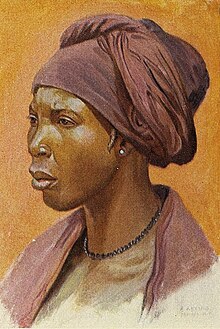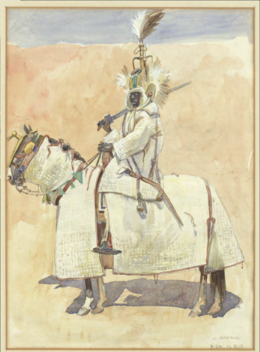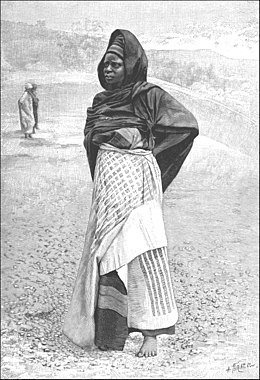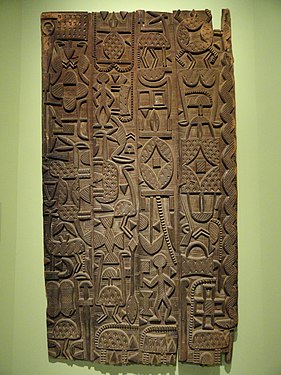Nupe people
 Watercolour drawing of a Nupe woman byCarl Arriens(1911) | |
| Total population | |
|---|---|
| c.3.5 million[1] | |
| Regions with significant populations | |
| Languages | |
| Nupe | |
| Religion | |
| PredominantlySunni Islam[2][3] | |
| Related ethnic groups | |
| Gbagyi,Igala,Yoruba,Ebira,Kambari,Kamuku,Bariba,Dukawa |
TheNupe(traditionally called theNupawaby theHausasandTapaby the neighbouringYoruba) are anethnic groupnative toNorth Central Nigeria.They are the dominant ethnic group inNiger Stateand a minority inKwara State.The Nupe are also present inKogi Stateand The Federal Capital Territory.[4][5]
History
[edit]The Nupe trace their origin toTsoedewho fled the court ofIdahand established a loose confederation of towns along theNigerin the 15th century.[6][7]The proximity of Nupe to the YorubaIgbominapeople in the south and to the YorubaOyopeople in the southwest led to cross-fertilization of cultural influences through trade and conflicts over the centuries.[8]In his bookThe Negro,African-American scholarW.E.B. Du Boiswrote that Nupe trade may have extended as far asSofalaand theByzantine Empire,with the latter of which, according to what he termed "credible legend," there was even an exchange of embassies.[9]
Population and demography
[edit]There are probably about 4.5 million Nupes,[10]principally inNiger State.TheNupe languageis also spoken inKwara,KogiandFederal Capital Territory.They are primarilyMuslims,with some Christians and followers ofAfrican Traditional Religion.The Nupe people have several local traditional rulers. The Etsu Nupe (Bida) is not pure Nupe, his great-grandfather from his father side isFulani,while the family of his mother was complete Nupe. His great-grandfather from his father side came to ruleBidain 1806 during theSokoto jihad.They have no present capital, although they were originally based at Raba and only moved to Bida in the 19th century.[11]

Traditions, art and culture
[edit]The Nupe people have various traditions. Many practices have changed as a result of the movements started bySokoto jihadof the 19th century, but they still hold on to some of their culture. Many Nupe people often havetribal markson their faces (similar to an old Igala tradition), some to identify their prestige and the family of which they belong as well as for protection, as well asjewelleryadornment. But these traditions are dying out in certain areas.[12][page needed]
Their art is often abstract. They are well known for theirwoodenstools with patterns carved onto the surface.[12][page needed]
The Nupe were described in detail by the ethnographerSiegfried Nadel,whose book,Black Byzantium,remains an anthropological classic.
Examples of Nupe art
[edit]-
Burtuwooden mask, used during bird hunting;Museum of Ethnology, Vienna.The hunter would tie the mask around his head and imitate the bird's movement.
-
Carved door; c. 1920 – 1940; wood with iron staples;Hood Museum of Art.
-
Wooden oval stool with incised carving;Los Angeles County Museum of Art.
Music and entertainment industry
[edit]
Nupe traditional music is sung by theNingba,or musician(s), while theEnyanicizhibeats the drum. Legendary Nupe singers of memory includeHajiya Fatima Lolo[13]Alhaji Nda'asabe, Hajiya Nnadzwa, Hauwa Kulu, Baba-Mini, Ahmed Shata and Ndako Kutigi.
The prime-movers of the Nupe cinema started film-making since the late 1990s into the early 2000s. Great Nupe personalities that birthed the idea of producing, acting and directing Nupe dramas/comedies on-screen are late Sadisu Muhammad DGN,[14]Prince Ahmed Chado, late Prince Hussaini Kodo, M.B. Yahaya Babs and Jibril Bala Jibril. They are the people who made the move for Nupe dramas to be on-screen and are the founders of the modern-day Nupe film industry[15]known asNupewood.[16]Nupewood has since produced more than a thousand entertaining movies in Nupe space to the millions of Nupe audiences.
Notable Nupe people
[edit]
- Shaikh Ahmad Lemu (OON, OFR)(1929–2020), Islamic scholar
- Hon. Justice Idris Legbo Kutigi (OFR, GCON)(1939–2018), Nigerian lawyer and chief justice of the Supreme Court of Nigeria
- Mohammed Umar Bago(born 1974), politician
- Muhammad Bima Enagi(born 1959), politician
- Muhammad Umaru Ndagi,academic professor (born 1964)
- Shehu Ahmadu Musa(1935–2008), politician
- Dangana Ndayako,politician and Senator in theThird Nigerian Republic
- Shaaba Lafiaji,politician
- Suleiman Takuma,journalist and political leader (1934–2001)
- Sam Nda-Isaiah(1962–2020), political columnist
- Jerry Gana,scholar and politician. Seecabinet of Olusegun Obasanjo
- Isa Mohammed Bagudu(born 1948), third republic politician
- Zainab Kure(born 1959), politician
- Abdulkadir Kure(1956–2017), politician and former Governor ofNiger Statein theFourth Nigerian Republic
- Aliyu Makama(1905–1980), Northern acting premiere
- H.R.H. Alhaji Yahaya Abubakar (GCFR)(born 1952), Etsu-Nupe; traditional ruler
- Mamman Jiya Vatsa(1940–1986), intellctual, military officer and former FCT minister
- Fatima Lolo(1891–1997), musician
References
[edit]- ^"Nupe"(PDF).National African Language Resource Center.Retrieved2021-10-04.
- ^Umaru Ndagi, Muhammad (January 2012)."Muslims of Niger State: A Survey"(PDF).University of Oxford.Retrieved13 April2023.
- ^"Nupe",Britannica.
- ^Nadel 2018,chapter 1.
- ^Yahaya, Mohammed Kuta (2003). "The Nupe People of Nigeria".Studies of Tribes and Tribals.1(2): 95–110.doi:10.1080/0972639x.2003.11886489.ISSN0972-639X.S2CID158674479.
- ^Mason, Michael (1975). "The Tsoede Myth and the Nupe Kinglists: More Political Propaganda?".History in Africa.2:101–112.doi:10.2307/3171467.ISSN0361-5413.JSTOR3171467.S2CID154712112.
- ^Lawal, Babatunde, 1942-.Tsoede, Sango, and the Nupe bronzes.OCLC57969198.
{{cite book}}:CS1 maint: multiple names: authors list (link) CS1 maint: numeric names: authors list (link) - ^Forde, Cyril Daryll. (1955).The Nupe.OCLC35809832.
- ^Du Bois, W.E.B.,The Negro,pp.28 and 49(Mineola, New York:Dover Publications,2001) (retrieved Jan. 20, 2024).
- ^"AFRICA | 101 Last Tribes - Nupe people".101lasttribes.Retrieved2023-02-18.
- ^Katcha, Abubakar. (1978).An exploratory demographic study of the Nupe of Niger State: the case of Sakpe village.Australian National University.ISBN0-909150-60-5.OCLC5021109.
- ^abNadel 2018.
- ^Umar, Aliyu.Hajiya Fatima Lolo (traditional singer).OCLC39524822.
- ^"Nupe Film Industry".
- ^"Nupe film industry is currently heading for the rocks – Yikangi".BluePrint.9 February 2015.
- ^Perani, Judith (2003).Nupe.Oxford Art Online. Oxford University Press.doi:10.1093/gao/9781884446054.article.t063036.
Sources
[edit]- Blench, R. M. (1984), "Islam among the Nupe."Muslim peoples.(edn 2), Boulder, Colorado: Westview Press.
- Forde, D. (1955), "The Nupe". pp. 17–52 inPeoples of the Niger-Benue Confluence.London: IAI.
- Ibrahim, Saidu (1992),The Nupe and their neighbours from the 14th century.Ibadan: Heinemann Educational Books.
- Madugu, George I. (1971), "The a construction in Nupe: Perfective, Stative, Causative or Instrumental". In Kim, C-W., & Stahlke, H.,Papers in African Linguistics, I,pp. 81–100. Linguistic Research Institute, Champaign.
- Nadel, S. F. (2018) [1954].Nupe Religion.African Ethnographic Studies of the 20th Century (eBook ed.). London & New York: Routledge.doi:10.4324/9780429487446.ISBN9780429487446.S2CID240282086.
- Perani, J. M. (1977),Nupe crafts; the dynamics of change in nineteenth and twentieth century weaving and brassworking.Ph.D. Fine Arts, Indiana University.
- Stevens, P. (1966),Nupe woodcarving.Nigeria, 88:21–35.
- Yahaya, Mohammed Kuta,The Nupe People of Nigeria.Nigeria, 95:1–2



